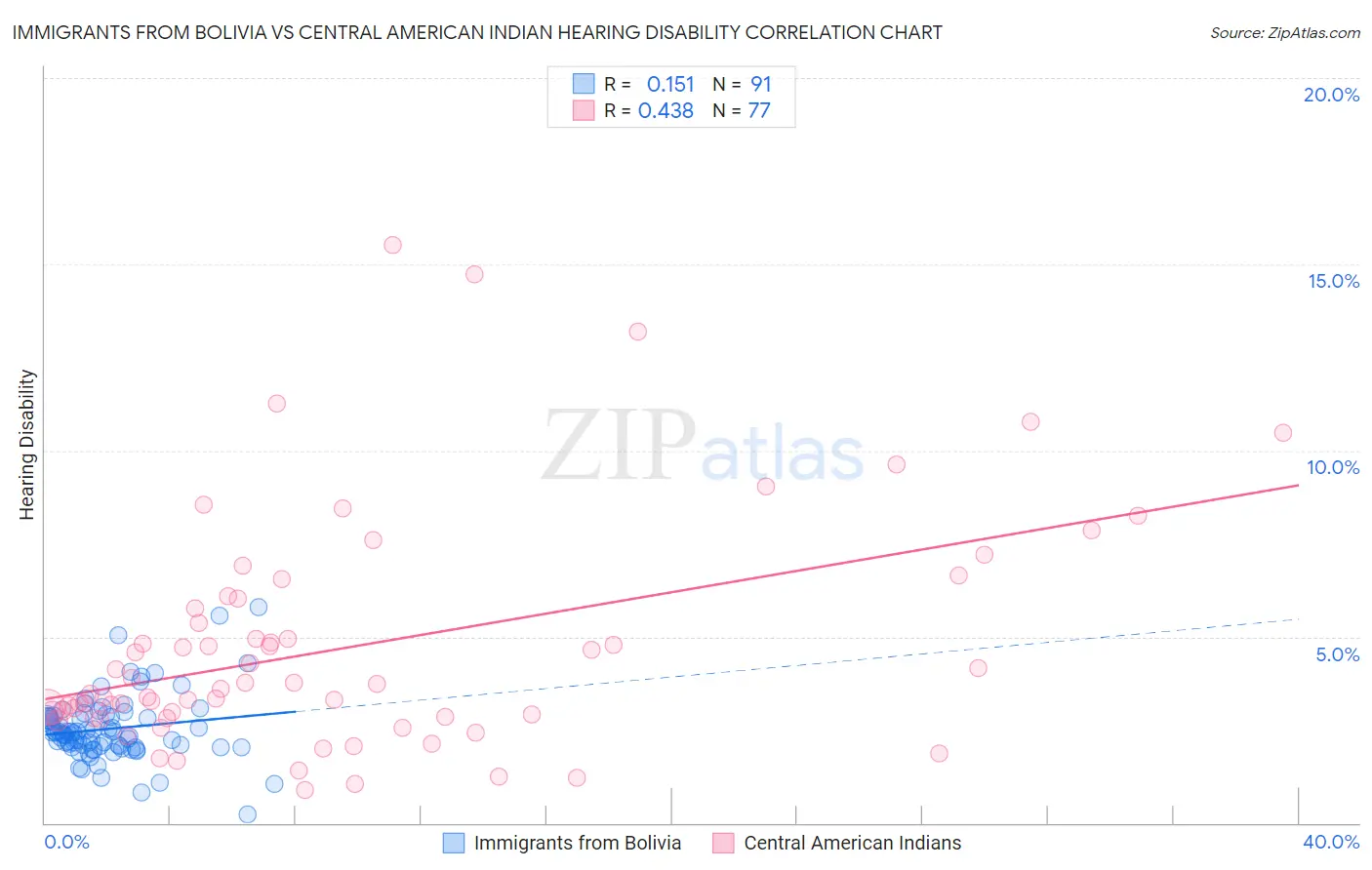Immigrants from Bolivia vs Central American Indian Hearing Disability
COMPARE
Immigrants from Bolivia
Central American Indian
Hearing Disability
Hearing Disability Comparison
Immigrants from Bolivia
Central American Indians
2.5%
HEARING DISABILITY
99.8/ 100
METRIC RATING
20th/ 347
METRIC RANK
3.3%
HEARING DISABILITY
2.3/ 100
METRIC RATING
234th/ 347
METRIC RANK
Immigrants from Bolivia vs Central American Indian Hearing Disability Correlation Chart
The statistical analysis conducted on geographies consisting of 158,707,824 people shows a poor positive correlation between the proportion of Immigrants from Bolivia and percentage of population with hearing disability in the United States with a correlation coefficient (R) of 0.151 and weighted average of 2.5%. Similarly, the statistical analysis conducted on geographies consisting of 326,061,009 people shows a moderate positive correlation between the proportion of Central American Indians and percentage of population with hearing disability in the United States with a correlation coefficient (R) of 0.438 and weighted average of 3.3%, a difference of 27.8%.

Hearing Disability Correlation Summary
| Measurement | Immigrants from Bolivia | Central American Indian |
| Minimum | 0.24% | 0.88% |
| Maximum | 5.8% | 15.5% |
| Range | 5.6% | 14.6% |
| Mean | 2.5% | 4.7% |
| Median | 2.4% | 3.6% |
| Interquartile 25% (IQ1) | 2.1% | 2.8% |
| Interquartile 75% (IQ3) | 2.9% | 5.9% |
| Interquartile Range (IQR) | 0.79% | 3.1% |
| Standard Deviation (Sample) | 0.88% | 3.1% |
| Standard Deviation (Population) | 0.87% | 3.1% |
Similar Demographics by Hearing Disability
Demographics Similar to Immigrants from Bolivia by Hearing Disability
In terms of hearing disability, the demographic groups most similar to Immigrants from Bolivia are Thai (2.5%, a difference of 0.050%), Dominican (2.5%, a difference of 0.070%), Ghanaian (2.5%, a difference of 0.070%), Immigrants from Sierra Leone (2.6%, a difference of 0.11%), and Immigrants from Nigeria (2.6%, a difference of 0.61%).
| Demographics | Rating | Rank | Hearing Disability |
| Sierra Leoneans | 99.9 /100 | #13 | Exceptional 2.5% |
| Ecuadorians | 99.9 /100 | #14 | Exceptional 2.5% |
| Barbadians | 99.9 /100 | #15 | Exceptional 2.5% |
| Immigrants | West Indies | 99.9 /100 | #16 | Exceptional 2.5% |
| Immigrants | India | 99.9 /100 | #17 | Exceptional 2.5% |
| Dominicans | 99.8 /100 | #18 | Exceptional 2.5% |
| Thais | 99.8 /100 | #19 | Exceptional 2.5% |
| Immigrants | Bolivia | 99.8 /100 | #20 | Exceptional 2.5% |
| Ghanaians | 99.8 /100 | #21 | Exceptional 2.5% |
| Immigrants | Sierra Leone | 99.8 /100 | #22 | Exceptional 2.6% |
| Immigrants | Nigeria | 99.8 /100 | #23 | Exceptional 2.6% |
| Immigrants | Ghana | 99.8 /100 | #24 | Exceptional 2.6% |
| Immigrants | El Salvador | 99.7 /100 | #25 | Exceptional 2.6% |
| Immigrants | Senegal | 99.7 /100 | #26 | Exceptional 2.6% |
| Immigrants | South Central Asia | 99.7 /100 | #27 | Exceptional 2.6% |
Demographics Similar to Central American Indians by Hearing Disability
In terms of hearing disability, the demographic groups most similar to Central American Indians are Estonian (3.3%, a difference of 0.070%), Guamanian/Chamorro (3.3%, a difference of 0.10%), Serbian (3.3%, a difference of 0.17%), Ukrainian (3.2%, a difference of 0.44%), and Luxembourger (3.2%, a difference of 0.49%).
| Demographics | Rating | Rank | Hearing Disability |
| Bhutanese | 4.6 /100 | #227 | Tragic 3.2% |
| Immigrants | Portugal | 4.3 /100 | #228 | Tragic 3.2% |
| Maltese | 4.1 /100 | #229 | Tragic 3.2% |
| Greeks | 3.2 /100 | #230 | Tragic 3.2% |
| Luxembourgers | 2.9 /100 | #231 | Tragic 3.2% |
| Ukrainians | 2.9 /100 | #232 | Tragic 3.2% |
| Estonians | 2.4 /100 | #233 | Tragic 3.3% |
| Central American Indians | 2.3 /100 | #234 | Tragic 3.3% |
| Guamanians/Chamorros | 2.2 /100 | #235 | Tragic 3.3% |
| Serbians | 2.2 /100 | #236 | Tragic 3.3% |
| Immigrants | Austria | 1.8 /100 | #237 | Tragic 3.3% |
| German Russians | 1.8 /100 | #238 | Tragic 3.3% |
| Nepalese | 1.2 /100 | #239 | Tragic 3.3% |
| Immigrants | Netherlands | 1.1 /100 | #240 | Tragic 3.3% |
| Samoans | 1.1 /100 | #241 | Tragic 3.3% |